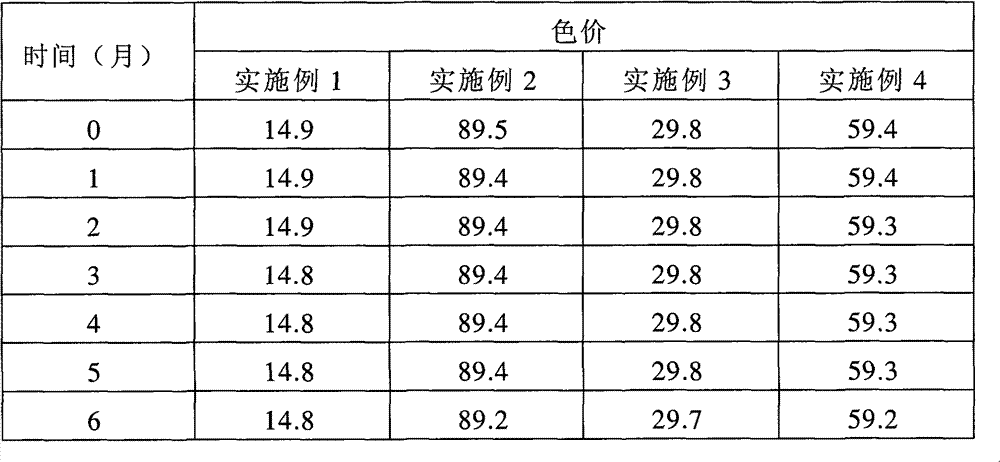Method for preparing capsanthin microcapsule
A technology of capsanthin and microcapsules, applied in the field of bioengineering, can solve the problems of difficulty in ensuring uniform emulsion, high energy consumption of spray drying, and affecting embedding effect, etc., achieve good coloring effect, good water solubility and stability, and improve The effect of product stability
- Summary
- Abstract
- Description
- Claims
- Application Information
AI Technical Summary
Problems solved by technology
Method used
Image
Examples
Embodiment 1
[0025] Capsanthin microcapsules with a color value of 150 were used as raw materials to prepare capsanthin microcapsules.
[0026] Add 1 g of vitamin E to 10 g of capsanthin, heat to 30° C. and stir for 10 minutes until the vitamin E dissolves, thereby obtaining a core material phase. Add 60g of modified starch into 100mL of water, heat to 50°C and stir for 30 minutes to dissolve the modified starch, then add 27g of dextrin and 2g of phospholipid, continue stirring for 30 minutes until the dextrin and phospholipid are dissolved, and cool to 20°C to obtain Capsule phase. The core material phase and the capsule material phase were mixed, and emulsified and homogenized by a high-pressure homogenizer at 20 MPa to obtain an emulsion with a particle size of 1000 nm. Under the conditions of 160°C inlet air temperature and 70°C outlet air temperature, the emulsion is dried in a spray drying tower to prepare capsanthin microcapsule powder.
[0027] Obtain 80g orange capsanthin microc...
Embodiment 2
[0030] Capsanthin microcapsules with a color value of 150 were used as raw materials to prepare capsanthin microcapsules.
[0031] Add 4 g of tert-butyl hydroquinone to 60 g of capsanthin, heat to 70° C. and stir for 10 minutes until the tert-butyl hydroquinone dissolves, thereby obtaining a core material phase. Add 20g of modified starch into 400mL of water, heat to 90°C and stir for 30 minutes to dissolve the modified starch, then add 10g of sucrose and 6g of vitamin C palmitate, continue stirring for 60 minutes until the sucrose and vitamin C palmitate are dissolved, and cool to 50°C to obtain a capsule phase. The core material phase and the capsule material phase were mixed, and emulsified and homogenized by a high-pressure homogenizer at 70 MPa to obtain an emulsion with a particle size of 300 nm. Under the conditions of an inlet air temperature of 210° C. and an outlet air temperature of 100° C., the emulsion is dried in a spray drying tower to obtain capsanthin microca...
Embodiment 3
[0034] Capsanthin microcapsules with a color value of 150 were used as raw materials to prepare capsanthin microcapsules.
[0035] Add 2kg of tert-butylhydroxyanisole to 20kg of capsanthin, heat to 50°C and stir for 15 minutes until the tert-butylhydroxyanisole dissolves, thereby preparing the core material phase. Add 30kg of modified starch into 200L of water, heat to 60°C and stir for 40 minutes to dissolve the modified starch, then add 44kg of lactose and 4kg of casein, continue stirring for 40 minutes until the lactose and casein are dissolved, and cool to 30°C to obtain Capsule phase. The core material phase and the capsule material phase were mixed, and emulsified and homogenized by a high-pressure homogenizer at 30 MPa to obtain an emulsion with a particle size of 670 nm. Under the conditions of 180°C inlet air temperature and 85°C outlet air temperature, the emulsion is dried in a spray drying tower to prepare capsanthin microcapsule powder.
[0036] Obtain 96.6kg or...
PUM
| Property | Measurement | Unit |
|---|---|---|
| particle diameter | aaaaa | aaaaa |
| particle diameter | aaaaa | aaaaa |
| particle diameter | aaaaa | aaaaa |
Abstract
Description
Claims
Application Information
 Login to View More
Login to View More - R&D
- Intellectual Property
- Life Sciences
- Materials
- Tech Scout
- Unparalleled Data Quality
- Higher Quality Content
- 60% Fewer Hallucinations
Browse by: Latest US Patents, China's latest patents, Technical Efficacy Thesaurus, Application Domain, Technology Topic, Popular Technical Reports.
© 2025 PatSnap. All rights reserved.Legal|Privacy policy|Modern Slavery Act Transparency Statement|Sitemap|About US| Contact US: help@patsnap.com

